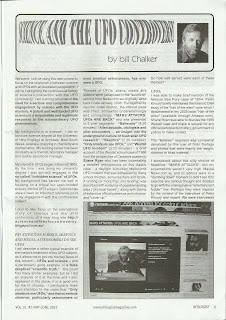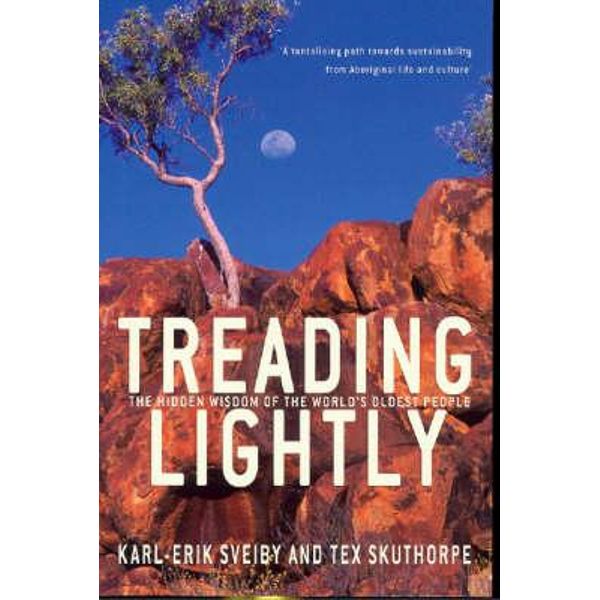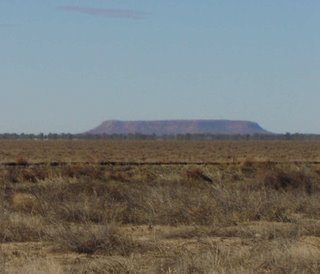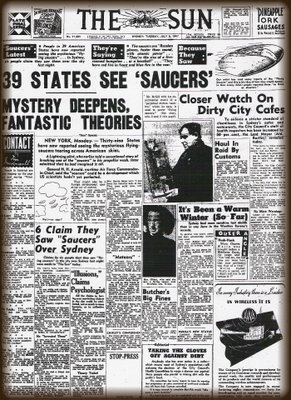
(This post was originally posted on "The OZ Files" site in May 2005)
This book is well worth examining, particularly by those tempted to speculate that the Wanjina (or Wandjinas - their most widespread spelling variant) are evidence of "extraterrestrials" visiting Earth. I have been a cautious traveller in this context. On my web site (www.theozfiles.com) and in my earlier book "The OZ Files - the Australian UFO Story" I speculate as follows:
The legends and lore of the indigenous aborigines also provide material suggestive of interactions with anomolous aerial phenomena. Of course, in speculation about such data, it should be realised that the accounts are of historical and anthroplological nature and therefore care should be taken not to interpolate too much into them.
Aboriginal myths incorporate the idea of "sky-beings", with the Wandjina being among the most interesting to consider. The Wandjin have been preserved in a fascinating oral tradition and in a large collection of rock paintings scatteredthroughout the Kimberley region of northern Australia. The paintings have received all manner of interpretations from stylised representations of a pervasive myth system to naive "ancient astronaut" theories. It is however fascinating to see that the indigenous tribes viewed the Wanjina as "the spirit in the cloud". Indeed, the unique painting style shows a logical sequence from human figures to stylised representations of clouds. This duality of anthropomorphic form and "clouds" is widespread in primitive cultures and finds an interesting parallel in the biblical accounts in "Exodus". While this line of thought is suggestive of superior "sky beings" acting as cultural catalysts for primitive societies, I should point out that making mythological component comparisons, can make for interesting exercises, full of emotive similarities, but are purely speculative.
Such speculations need to have their anchor points in the living and preserved traditions of the people who view the Wanjinas as their primary "religious" focus. To not do so is to ignore a primary and fascinating source of oral and pictorial knowledge about these extraordinary beings - the Wanjinas.
Their resonances with some alien descriptions and contemporary alien abduction lore is fascinating. In my new book "HAIR of the ALIEN" I refer to a witness' description of entities, which was described by prominent "alien abduction" claimant Whitley Strieber as "the best description of the gray beings". For the witness - an Australian woman - "the most strikingly similar image to that of the beings is the Wandjina - the haunting Australian aboriginal rock paintings that reveal figures with large dark eyes and no mouth."
An excellent new book on the Wandjina (or Wanjinas) "Keeping the Wanjinas fresh" by Kimberely Wanjina artist & carer Donny Woolagoodja and anthropologist Valda Blundell strikingly documents the Wanjina rock paintings and the living tradition that is being keep "fresh" through "touching" up the old rock paintings and creating new "modern" expressions of the Wanjina - "eternal manifestations of the sacred life force ... the supernatural ancestors" of the local aborigines (including the Worrorra, Ngarinyin and the Wunambal). Donny Woolagoodja has a direct linkage to the "retouching" tradition through his father Sam Woolagoodja.
The book highlights "the Wanjinas created the countries that their human descendants belong to and they made the laws that guide their everyday lives. Visible as paintings at hundreds of rock art sites throughout their countries, the Wanjinas remained sources of strength for Sam and his people during the tumultuos years of colonisation. Even after the Worrora were displaced from their countries, the Wanjinas continued to instruct them in their dreams." Further the book highlights "Expressions of the Wanjinas can be seen in the night sky, for instance the Milky Way. They are also closely associated with clouds and water ... Sam once told (Blundell) that the Wanjinas 'came through clouds'. "That's their home,' he said; 'they come from rain.' People are 'born in sunlight', while Wanjinas are 'born in the dark'.
People around the world would have seen the Wanjina rising from the ground in the opening ceremony of the 2000 Sydney Olympics. Donny Woolagoodja was the traditional artist behind that extraordinary display. Most pivotal in the book, beyond the beautiful contemporary Wanjina artwork, is the "refreshing" tradition among chosen local people.
I noted that Donny's "refreshing" of the the rock painting Wanjina Namarali at Karndirrim in 2002 made some "changes" to the old original representation, most noteably giving it a much thinner neck, a head leaning to one side and longer arms. I wondered about the importance of this but the book elaborates "while most of the Wanjinas have lost their mouths, they are still able to instruct people in their dreams. According to Donny, those aspects of recent paintings that appear to be 'new' are actually contemporary revelations of Lalai ("the primeval era of creation" or "the Dreaming" - an eternal sense of "living cosmology") . Donny explains, 'When I paint, I follow the dream.' "
This book is well worth examining, particularly by those tempted to speculate that the Wanjina (or Wandjinas - their most widespread spelling variant) are evidence of "extraterrestrials" visiting Earth. I have been a cautious traveller in this context. On my web site (www.theozfiles.com) and in my earlier book "The OZ Files - the Australian UFO Story" I speculate as follows:
The legends and lore of the indigenous aborigines also provide material suggestive of interactions with anomolous aerial phenomena. Of course, in speculation about such data, it should be realised that the accounts are of historical and anthroplological nature and therefore care should be taken not to interpolate too much into them.
Aboriginal myths incorporate the idea of "sky-beings", with the Wandjina being among the most interesting to consider. The Wandjin have been preserved in a fascinating oral tradition and in a large collection of rock paintings scatteredthroughout the Kimberley region of northern Australia. The paintings have received all manner of interpretations from stylised representations of a pervasive myth system to naive "ancient astronaut" theories. It is however fascinating to see that the indigenous tribes viewed the Wanjina as "the spirit in the cloud". Indeed, the unique painting style shows a logical sequence from human figures to stylised representations of clouds. This duality of anthropomorphic form and "clouds" is widespread in primitive cultures and finds an interesting parallel in the biblical accounts in "Exodus". While this line of thought is suggestive of superior "sky beings" acting as cultural catalysts for primitive societies, I should point out that making mythological component comparisons, can make for interesting exercises, full of emotive similarities, but are purely speculative.
Such speculations need to have their anchor points in the living and preserved traditions of the people who view the Wanjinas as their primary "religious" focus. To not do so is to ignore a primary and fascinating source of oral and pictorial knowledge about these extraordinary beings - the Wanjinas.
Their resonances with some alien descriptions and contemporary alien abduction lore is fascinating. In my new book "HAIR of the ALIEN" I refer to a witness' description of entities, which was described by prominent "alien abduction" claimant Whitley Strieber as "the best description of the gray beings". For the witness - an Australian woman - "the most strikingly similar image to that of the beings is the Wandjina - the haunting Australian aboriginal rock paintings that reveal figures with large dark eyes and no mouth." post was originally published on "The OZ Files" site in May 2005)
An excellent new book on the Wandjina (or Wanjinas) "Keeping the Wanjinas fresh" by Kimberely Wanjina artist & carer Donny Woolagoodja and anthropologist Valda Blundell strikingly documents the Wanjina rock paintings and the living tradition that is being keep "fresh" through "touching" up the old rock paintings and creating new "modern" expressions of the Wanjina - "eternal manifestations of the sacred life force ... the supernatural ancestors" of the local aborigines (including the Worrorra, Ngarinyin and the Wunambal). Donny Woolagoodja has a direct linkage to the "retouching" tradition through his father Sam Woolagoodja.
The book highlights "the Wanjinas created the countries that their human descendants belong to and they made the laws that guide their everyday lives. Visible as paintings at hundreds of rock art sites throughout their countries, the Wanjinas remained sources of strength for Sam and his people during the tumultuos years of colonisation. Even after the Worrora were displaced from their countries, the Wanjinas continued to instruct them in their dreams." Further the book highlights "Expressions of the Wanjinas can be seen in the night sky, for instance the Milky Way. They are also closely associated with clouds and water ... Sam once told (Blundell) that the Wanjinas 'came through clouds'. "That's their home,' he said; 'they come from rain.' People are 'born in sunlight', while Wanjinas are 'born in the dark'.
People around the world would have seen the Wanjina rising from the ground in the opening ceremony of the 2000 Sydney Olympics. Donny Woolagoodja was the traditional artist behind that extraordinary display. Most pivotal in the book, beyond the beautiful contemporary Wanjina artwork, is the "refreshing" tradition among chosen local people.
I noted that Donny's "refreshing" of the the rock painting Wanjina Namarali at Karndirrim in 2002 made some "changes" to the old original representation, most noteably giving it a much thinner neck, a head leaning to one side and longer arms. I wondered about the importance of this but the book elaborates "while most of the Wanjinas have lost their mouths, they are still able to instruct people in their dreams. According to Donny, those aspects of recent paintings that appear to be 'new' are actually contemporary revelations of Lalai ("the primeval era of creation" or "the Dreaming" - an eternal sense of "living cosmology") . Donny explains, 'When I paint, I follow the dream.' "
This book is well worth examining, particularly by those tempted to speculate that the Wanjina (or Wandjinas - their most widespread spelling variant) are evidence of "extraterrestrials" visiting Earth. I have been a cautious traveller in this context. On my web site (www.theozfiles.com) and in my earlier book "The OZ Files - the Australian UFO Story" I speculate as follows:
The legends and lore of the indigenous aborigines also provide material suggestive of interactions with anomolous aerial phenomena. Of course, in speculation about such data, it should be realised that the accounts are of historical and anthroplological nature and therefore care should be taken not to interpolate too much into them.
Aboriginal myths incorporate the idea of "sky-beings", with the Wandjina being among the most interesting to consider. The Wandjin have been preserved in a fascinating oral tradition and in a large collection of rock paintings scatteredthroughout the Kimberley region of northern Australia. The paintings have received all manner of interpretations from stylised representations of a pervasive myth system to naive "ancient astronaut" theories. It is however fascinating to see that the indigenous tribes viewed the Wanjina as "the spirit in the cloud". Indeed, the unique painting style shows a logical sequence from human figures to stylised representations of clouds. This duality of anthropomorphic form and "clouds" is widespread in primitive cultures and finds an interesting parallel in the biblical accounts in "Exodus". While this line of thought is suggestive of superior "sky beings" acting as cultural catalysts for primitive societies, I should point out that making mythological component comparisons, can make for interesting exercises, full of emotive similarities, but are purely speculative.
Such speculations need to have their anchor points in the living and preserved traditions of the people who view the Wanjinas as their primary "religious" focus. To not do so is to ignore a primary and fascinating source of oral and pictorial knowledge about these extraordinary beings - the Wanjinas.
Their resonances with some alien descriptions and contemporary alien abduction lore is fascinating. In my new book "HAIR of the ALIEN" I refer to a witness' description of entities, which was described by prominent "alien abduction" claimant Whitley Strieber as "the best description of the gray beings". For the witness - an Australian woman - "the most strikingly similar image to that of the beings is the Wandjina - the haunting Australian aboriginal rock paintings that reveal figures with large dark eyes and no mouth."























